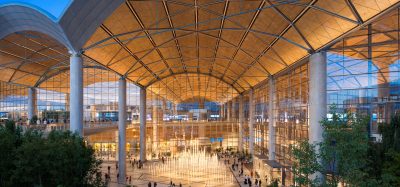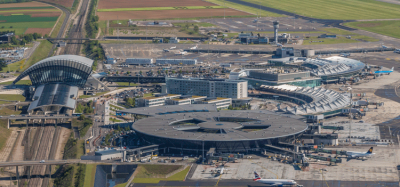Facing the fuel efficiency challenge
Posted: 16 March 2005 | Ravin Appadoo, Assistant Director, IATA Fuel Services | No comments yet
Improving fuel efficiency is one of the greatest challenges for the aviation industry – and airports have their role to play in achieving the goal for more efficient air travel, writes Ravin Appadoo.
Improving fuel efficiency is one of the greatest challenges for the aviation industry – and airports have their role to play in achieving the goal for more efficient air travel, writes Ravin Appadoo.
Without doubt, the price of fuel is the biggest crisis facing the airspace user today. The high price of jet fuel is wreaking havoc in the airlines’ financial fortunes, with a 2004 fuel bill of US$62 billion, a staggering US$15 billion increase on 2003. The prospect of a return to profitability for the industry – on the premise of an oil market going back to the US$34 a barrel of crude after having peaked at US$55 in New York last October – is proving to be very grim. In fact, it appears that the oil market forward curves are at historic highs and are here to stay.
With alternative fuels offering little promise for the future, and the lack of control over price, the only hope for winning the battle to reduce energy costs is through greater operational efficiency.
Fuel efficiency is a pervasive concept that touches almost every aspect of the industry from aircraft design and construction through to aviation regulatory requirements to airline operation and air navigation service provision. This article will attempt to explore the current and potential contribution from all of these areas. The environmental factor as a driver of fuel efficiency is also discussed, as well as the battery of measures that airlines in particular are deploying in their attempt to mitigate the impact of high fuel prices on their operations. This article will finally highlight the initiatives and measures taken by IATA in the context of the recently launched industry-wide ‘Fuel Action Campaign’.
Aircraft design and fuel efficiency
The trend for fuel efficiency of jet aircraft has been one of almost continuous and incremental improvement; fuel burned per seat in today’s new aircraft is 70% less than that of early jets. About 40% of the improvement has come from engine efficiency improvements and 30% from airframe efficiency improvements. Historically, these improvements have averaged 1-2% per year for new production aircraft (Koff, 1991; Albritton et al., 1996; Condit, 1996). The relatively steady and continuous rate of improvement observed during several decades is likely to continue in the future. In the longer term (2050) compared to 1997, a total aircraft production average fuel-efficiency improvement of 40–50% is considered feasible (ICCAIA, 1997g).
Improvement in engine fuel efficiency has come mainly from the increasing use of modern high-bypass engine technology that relies on increasing engine pressure ratios and higher temperature combustors as a means to increase engine efficiency. Recent aerodynamic technologies, such as supercritical airfoils and winglets, have already provided substantial increases in aerodynamic efficiency against first-generation jet transports and there are many emerging aerodynamics technologies worthy of development and implementation. One of the most promising, especially for improving efficiency in jet transports, is laminar flow control.
The new planes also rely on a greater use of the lighter composite materials rather than conventional aluminium. The A380 is evidence of Airbus’ faith in the increasing use of composites. Some 25% of the aircraft is built using composite material – 22% carbon fibre reinforced plastic and 3% GLARE fibre-metal laminate, which is being used for the first time on a civilian airliner.
Also for the first time the aircraft has a composite centre wing-box, a crucial primary structure that connects the wings to the fuselage. Another first is the composite rear fuselage section behind the rear pressure bulkhead. As well as these composites the A380 has a significant proportion of advanced metallic materials, which also offer advantages such as operational reliability and ease-of-repair and maintenance. However, weight saving is one of the greatest advantages of composites, leading to less fuel burn, fewer emissions and lower operating costs.
The fuel intensity per passenger kilometre of commercial civil air transport has been reduced by approximately 50% since the early 1970s. The use of more fuel-efficient aircraft engines and the introduction of bigger aircraft accommodating more seats per aircraft in combination with an increase in the average stage distances have reduced the fuel use per available seat kilometre (ASK). Furthermore, the improvement in specific fuel consumption has reduced the necessary amount of fuel that has to be carried on flights of comparable distances leading to additional fuel savings. In addition, the operation at higher passenger load factors has contributed to reduce the fuel use per revenue passenger kilometer (RPK).
Competing for fuel efficiency!
More than ever before, fuel efficiency has become a key determinant in an airline’s choice of aircraft type. It is interesting to note that Boeing advertises the B787 Dreamliner as the ‘Chief Efficiency Officer’. Boeing has emphasised the flexibility and fuel efficiency of the B787, which seats 217 to 289 passengers and has a range of up to 8,500 nautical miles. Boeing says the jet will be 20% more fuel-efficient than comparable planes now on the market.
At the recent inauguration of the Airbus A380, the Airbus officials claimed an advantage in capacity, range and fuel efficiency that drops the cost per passenger 20% compared to the 747-400. Airbus says the A380 offers a gain in fuel use of some 15% when compared with Boeing’s top-of-the-range 747-400. At a cruising speed of 900km per hour, the plane delivers a consumption of three litres of fuel per passenger per 100km travelled, according to Airbus. It cites a figure of 3.4 litres for the 747-400.
As air traffic recovers to pre 9/11 levels, high fuel costs and fuel efficiency remain key considerations in the airline’s choice of new aircraft. Boeing and Airbus offer two different approaches to reach the same goal with the Boeing’s B787 being 20% more fuel-efficient than older models and the A380 having the advantage of carrying more people.
Air Traffic Management (ATM)
The urgent need for radical improvement of the ATM system to accommodate the continuing growth of aviation and to promote efficient airspace use is recognised by all. The current system and its subsystems suffer from deficiencies in the technical, operational, political, procedural, economic, social and implementation areas.
Much enroute and terminal area ATM systems and airport infrastructure used has not changed since the 1950s. Although much has been done the industry is still short of the desired efficient and seamless ATM system. Fundamentally, ICAO’s Global Operational Concept, which aims at a ‘Single Sky over a Single Market’, offers a solution.
IATA has fully embraced this concept and in concert with its industry partners, has developed an ATM Implementation Roadmap, which was delivered to ICAO on the 15th October 2004. The new concept for ATM, with enhanced communications, navigation, and surveillance/air traffic management (CNS/ATM) systems, benefits the air transportation sector by reducing delays, increasing the capacity of existing infrastructure and improving operational efficiency. The implementation of the new CNS/ATM system is currently underway and is resulting in fuel savings as well as reduced emissions. Several studies conducted suggest that improvements in ATM could help to improve overall fuel efficiency by 6-12%.
Meanwhile various initiatives are underway in the industry to enhance ATM capabilities and efficiency. One such example is Boeing’s air traffic management (ATM) unit, which involves using new satellite navigation technology in North America and Europe. Boeing states that ‘continuous descent approaches’ can improve efficiency and reduce noise and emissions when aircraft land. Under this system, electronic data guides the aircraft on its descent using “the most efficient path to its destination,” according to Kevin Brown, Boeing’s vice president and general manager of Advanced ATM. Clearance instructions are also transmitted electronically to arriving aircraft, negating the need for multiple voice transmissions. Such arrivals could save between 400 and 800lbs of fuel per flight, which adds up to more than US$100,000 in annual cost savings for each aircraft, Boeing officials say. Early tests conducted using an Airbus A330 and a Boeing 747-400 in Australia have demonstrated reductions in fuel, noise and also cut controller workload and frequency congestion.
Reduced vertical separation minimum (RVSM)
More potential savings, of at least US$ 5 billion in the next decade, may be yielded by the FAA’s recent doubling of the airspace routes between 29,000 feet and 41,000 feet (achieved by increasing the spacing of aircraft to a thousand feet apart). Increasing the number of high altitude routes gives pilots and air traffic controllers more choices so that aircraft can fly more direct routes at the most fuel-efficient altitudes, saving time and money for airlines and travellers alike.
The horizontal separation of aircraft in high altitude airspace remains at five-plus miles. RVSM has been implemented safely in the last seven years, in less complex airspace from Europe to Australia and over most of the North Atlantic and Pacific Oceans. In Europe the successful implementation of RVSM and associated airspace reorganisation, through Eurocontrol has enabled considerable delay reduction.
In 2000, the FAA also installed a new flight planning and coordination control tool, called the Departure Spacing Program (DSP). This helps the FAA “deliver uninterrupted, safe service to its clients while reducing communication inefficiencies and increasing air traffic control flexibility.” The DSP enables air traffic controllers to work more efficiently with traffic management coordinators to better use existing capacity for departing aircraft. The system reduces departure-sequencing delays and minimises terminal-area ground, airspace and telephone congestion.
Fuel reserves
Furthermore, last summer the FAA relaxed the 10% fuel reserve requirement for aircraft on international flights; smaller reserves on international flights reduce weight and save money. The FAA plans to help airlines reduce fuel costs by 1% through 2008. However, the organisation states that because of safety concerns, waivers on fuel requirements for international routes are granted on a case-by-case basis. So far, American Airlines and Continental Airlines have been permitted to carry less fuel, with American claiming to reduce its fuel bill by US$10.5 million a year through this new policy. The potential for savings through reduced fuel reserves is much less for European carriers, as they already operate with contingency fuel less than half that of their US counterparts.
Airports
Airport operations can also have a large impact on fuel use and environmental effects. Congested airports are the main concern. One of IATA’s service offerings in the consulting area is aircraft flow simulation at airports. Using a simulation model IATA has been able to determine delays by considering first the existing rules and procedures and secondly the best practices and facility improvements required to remove limitations. Comparison of before and after delays is used to estimate fuel cost savings to justify improvements.
Good apron management techniques on the part of airport authorities can contribute to reduce bottlenecks and contribute to better fuel management. Areas would include effective and coordinated gate allocation, to prevent stand-offs and stop/start taxiing and the use of ground power instead of APUs, which are used to run the air-conditioning system of an aircraft parked at the gate. Ground power units whether they use electricity or are diesel powered cost considerably less to run, although it should be remembered this should be considered on a case-by-case basis. There is also a need to raise the airports authorities’ awareness of the fuel crisis and to encourage them to look for every opportunity to assist airlines in reducing fuel burn.
Fuel efficiency – the environmental dimension
The total annual aviation fuel consumption is estimated to be in excess of 44 billion US gallons. A 1% saving would amount to a reduction in fuel consumption of 440 million gallons (1.33 million tons). The environmental impact can be even more dramatic. It is known that per ton of fuel, 3.154 tons of CO2 are released from the combustion process in the atmosphere. Thus on CO2 alone, some 4.2 million tons less will be released into the atmosphere. In decreasing importance will follow other pollutants and greenhouse gases like H2O, NOX, SO2 and CO.
IATA Members plan to achieve an additional 10% fuel efficiency improvement in their total fleet by 2010, relative to 2000 levels. This could reduce the total release of carbon dioxide emissions into the atmosphere in this period by almost 350 million tons compared to a scenario in which year 2000 efficiency levels would be ‘frozen’. Airlines for their part are also deploying a battery of measures designed to economise on the fuel burn of their fleet. While some of these practices have been in use for years in an unsystematic manner, they are now being implemented with renewed urgency across the industry to cope with rising costs and cutthroat competition. Such measures include maximising load factors, optimising the position of the centre of gravity when loading, reducing taxi time with fewer engines between gate and runway and using electrically driven GSE.
An increased awareness exists of aviation’s growing impact on the environment in terms of noise, local air quality and climate change and accordingly there are a plethora of regulatory initiatives designed to address this impact. Some regulators envisage the inclusion of aviation in the EU’s emission trading scheme as early as 2008. Emissions trading involves governments setting CO2 emission limits for individual industries and companies. It then allows participants in the emissions trading scheme to purchase allowances from the market to cover any emissions in excess of their own emissions limits. Similarly, participants who emit less than their own allocation can sell their surplus allowances.
British Airways has taken the lead in this area and is already a member of the voluntary UK emissions trading scheme. At this stage, the scheme only covers BA’s domestic operation and UK properties. Nonetheless, BA claims to have achieved an impressive 17% reduction in emissions compared to the scheme 1998-2000 baseline level. But, political consensus on the issue, even within Europe, may be difficult to achieve.
IATA agrees with ICAO that emissions trading may be a more cost-effective way of addressing aviation greenhouse gas emissions than taxes or charges. It is therefore supporting ICAO’s continuing studies on emissions trading. Given the potentially large impact an emissions trading scheme may have, it is essential this issue is carefully considered. A detailed understanding is required of the structure of such schemes, the environmental merits, the economic and social effects and the potential for competitive distortion. Moreover, airlines will be looking at governments to assume their responsibility too, by working with infrastructure providers to ensure sufficient airport and airspace capacity. This would further reduce congestion and delays and hence fuel burn and emissions.
IATA Fuel Action Campaign
With annual operating costs for our industry of about US$375 Billion – of which more than US$60 billion is attributable to fuel, a reduction in fuel cost, or fuel use, of just 1% would save the airspace users US$700 Million per year.
Market forces drive fuel cost, but fuel use or consumption is strongly affected by airline fuel management and ATM. Leading the efforts in this area, IATA initiated a Fuel Action Plan in September 2004. The ‘Fuel Campaign’, as it was subsequently called, focuses on areas such as fuel efficiency best practice, route optimisation and airport improvement, taxes and levies on jet fuel, invoicing costs, hedging etc. As the campaign unfolded, it became evident that the ‘quick wins’ would come essentially from the route improvement initiative where new routes were opened and others realigned. In fact, the estimated benefit since the launch of Fuel Action Plan was US$85.3 million (September – December 2004). Estimated benefits for 2005 from route improvements are expected to be in excess of US$700 million. Major achievements include flexible flight planning and transpolar route access in China, new and realigned routes in Middle East, non-ECAC route improvements in Europe and North American random routes off North Atlantic Tracks to West Coast USA.
IATA has stated that these savings should be easily achieved if States and Air Navigation Service Providers (ANSP’s) were cogniscent of the concerns of airspace users. To this end, IATA has initiated a ‘Save a Minute’ Campaign, asking ANSP’s to save just one minute through better design and/or management of their airspace. Its sounds simple, but this action alone would save airspace users a staggering US$1 billion a year in total operating cost.
IATA has contacted all ANSP’s and many have responded positively. IATA is also working with the most senior levels of ICAO. The ICAO Regional Planning and Implementation Groups (PIRGS) have agreed to place the appropriate priority and emphasis on environment and fuel saving. It is important that all stakeholders recognise this issue as their priority and not just the airspace users.
Community-wide engagement
Barring a sudden slump in the world economy, the high price of oil and petroleum products is likely to prevail. There are indications that the various industries dependent on fossil energy are adjusting to the new price levels. Against this backdrop, the pressure for greater fuel efficiency will remain, if not accentuate further, as airlines try to survive in the cut-throat competitive environment of today.
The technological ‘push’, fuelled by competition for the most, and the environmental ‘pull’ from policy makers, will contribute to make fuel efficiency a primary goal for the industry. The industry is poised to deliver up to 20% better fuel efficiency from combined airframe and engine technological improvements. This, combined with a 5-13% contribution from optimised airline operational efficiency and a 6-10% gain from CNS/ATM improvement suggest that overall the industry can expect efficiency gains of the order of 30% in the coming years. This is the promise that the fuel efficiency goal holds for the future.
As the airlines exhaust every single avenue within their control for saving fuel, they need to look beyond and actively engage other stakeholders such as the airports and ANSPs, where further optimisation can be achieved. It will take a community-wide engagement to reach the next level of fuel efficiency.
Ravin Appadoo
Ravin Appadoo joined IATA following a 15-year career with Air Mauritius. His responsibilities ranged from purely engineering, operational and technical through to consulting and finance-related issues. At IATA he plays a key role in both the commercial and technical aspects of Fuel Services activity. Fuel Services has primary responsibility for all fuel technical activity, including the Aviation Fuel Working Group and the IATA Fuel Quality Pool. It also assists in supporting fuel commercial activity including the semi-annual Fuel Trade Meetings. He plays a leading role in the recently launched IATA ‘Fuel Action Campaign’.
The International Airport Summit is open for registration!
Date: 19 – 20 November 2025
Location: JW Marriott Hotel Berlin
At our flagship event of the year, we will dive into the future of airport operations, with expert-led sessions on passenger experience, innovative smart technologies, baggage handling, airside operations, data, security, and sustainability.
This is where global airport leaders come together to share insights, challenges, and real-world solutions.
Limited complimentary passes are available for eligible professionals – first come, first served!

















